From Black Collar Arms:
Originally developed as a joint effort between Lamborghini and Callaway Golf Company, the forged carbon fiber process can produce complex shapes one-third the weight of titanium, yet stronger. Partnering with manufacturing company McVick, Black Collar Arms is excited to bring the world of forged carbon fiber components to a firearm near you.
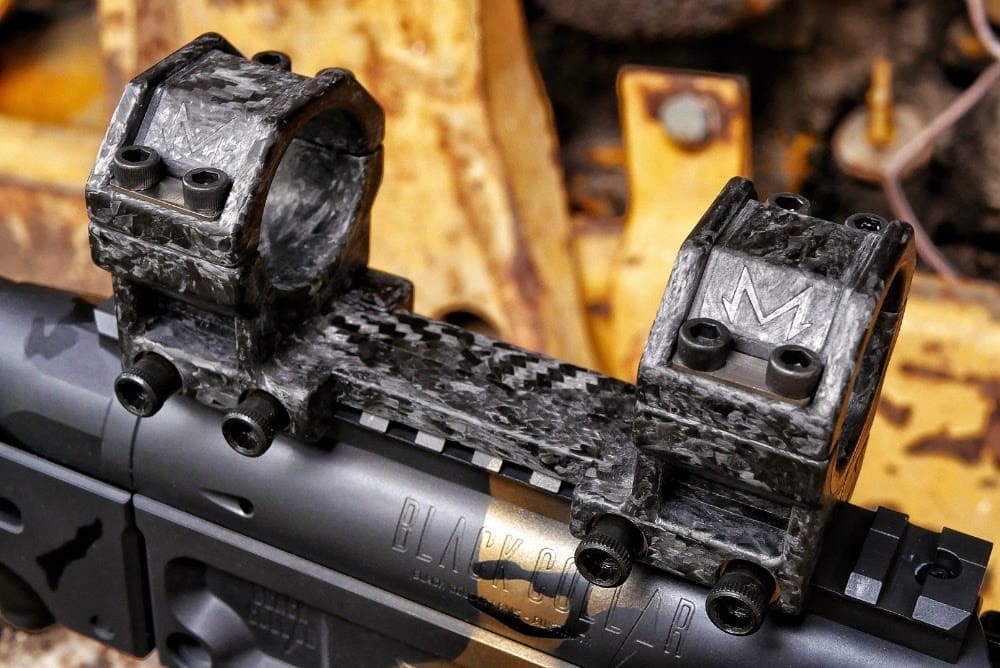
Available first are Forged Carbon Fiber One-Piece Scope Mounts in 30mm and 34mm ring sizes. Despite weighing in at a scant 5.2 ounces, these forged carbon fiber scope mounts are as stiff and rigid as if they were machined from steel (three times stiffer than aluminum!) with just 1/6th the thermal expansion of aluminum.
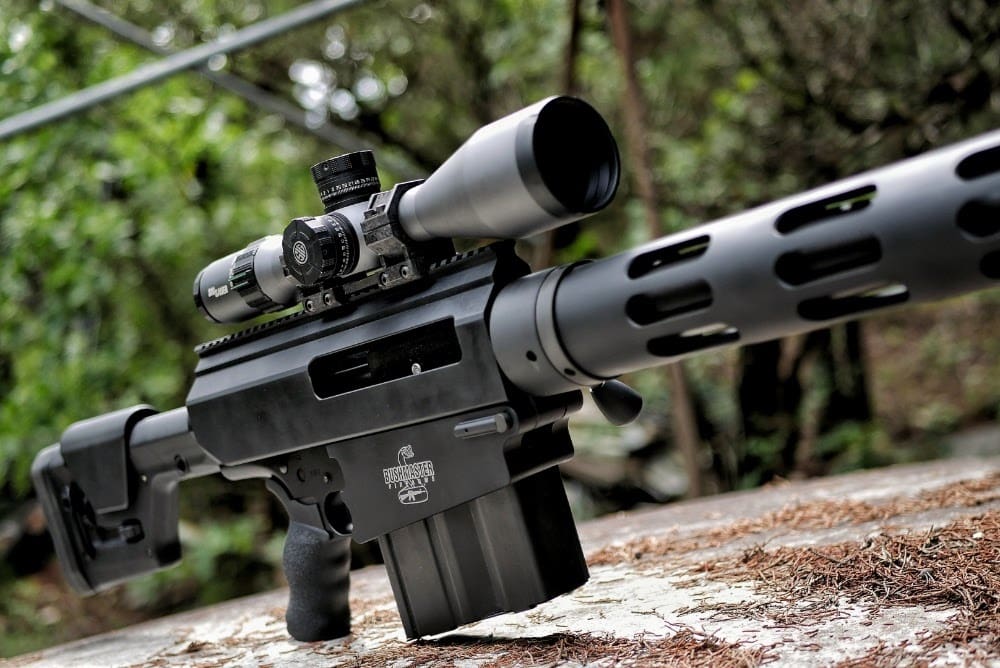
These are the most rigid scope mounts on the market and maintain flawless zero in any conditions. As if the gorgeous carbon fiber aesthetic wasn’t enough!
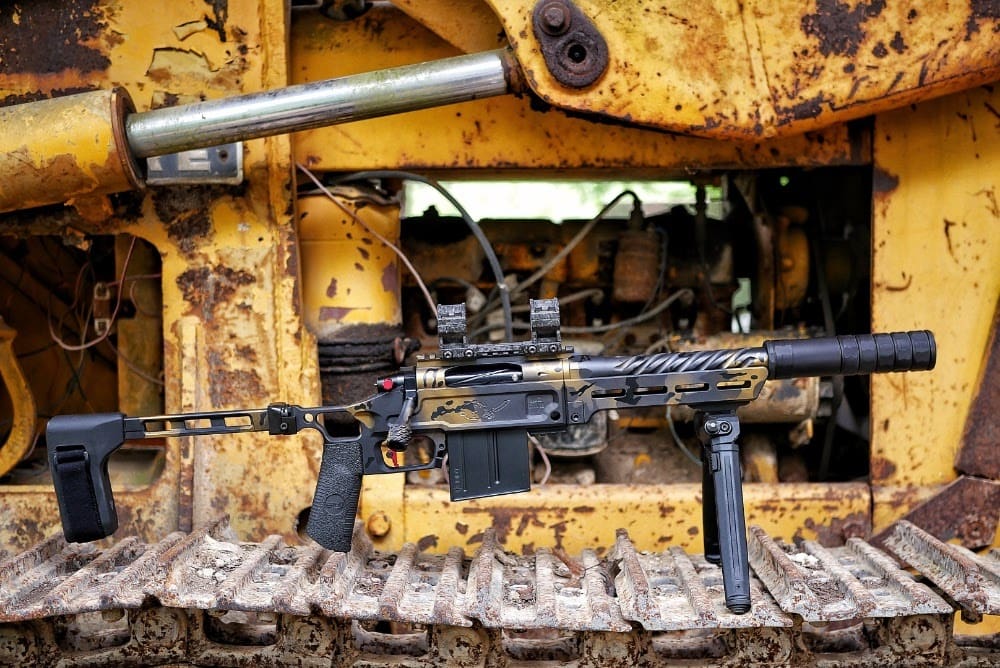
After over 18 months of engineering and R&D time, including extensive physical stress and UV exposure testing, McVick launched the Forged Carbon Fiber One-Piece Scope Mount. It’s now the first in an upcoming line of forged carbon fiber components to be manufactured by McVick exclusively for Black Collar. Expect further optic mounting solutions plus other accessories and components, including AR-15 parts.
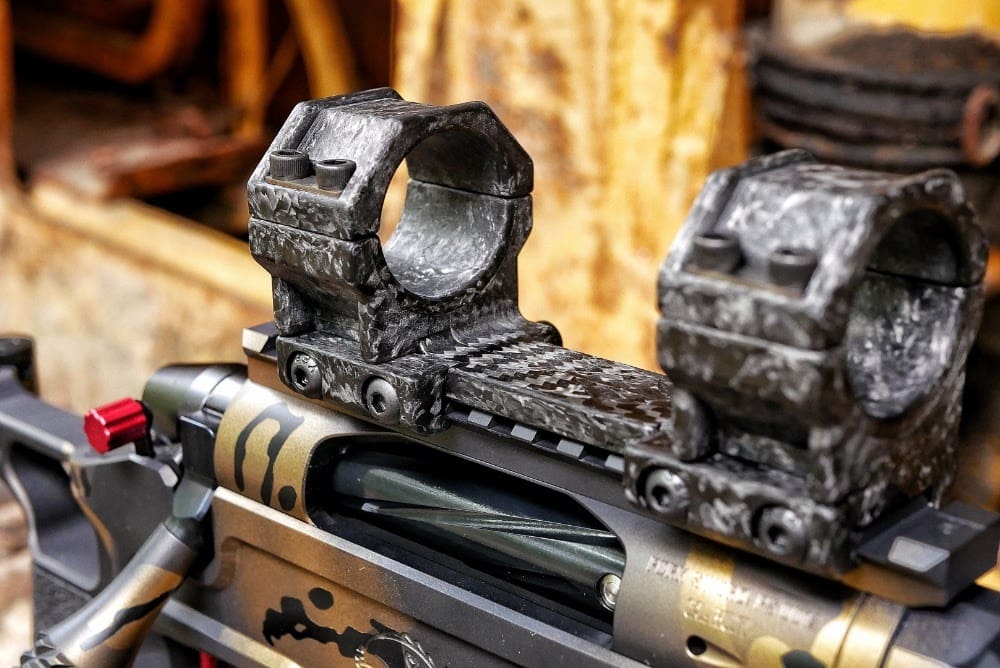
Quality is extremely high, but current production capacity is low. Mount availability will be rather limited with small batches arriving at Black Collar weekly while we gradually invest in increasing capacity.
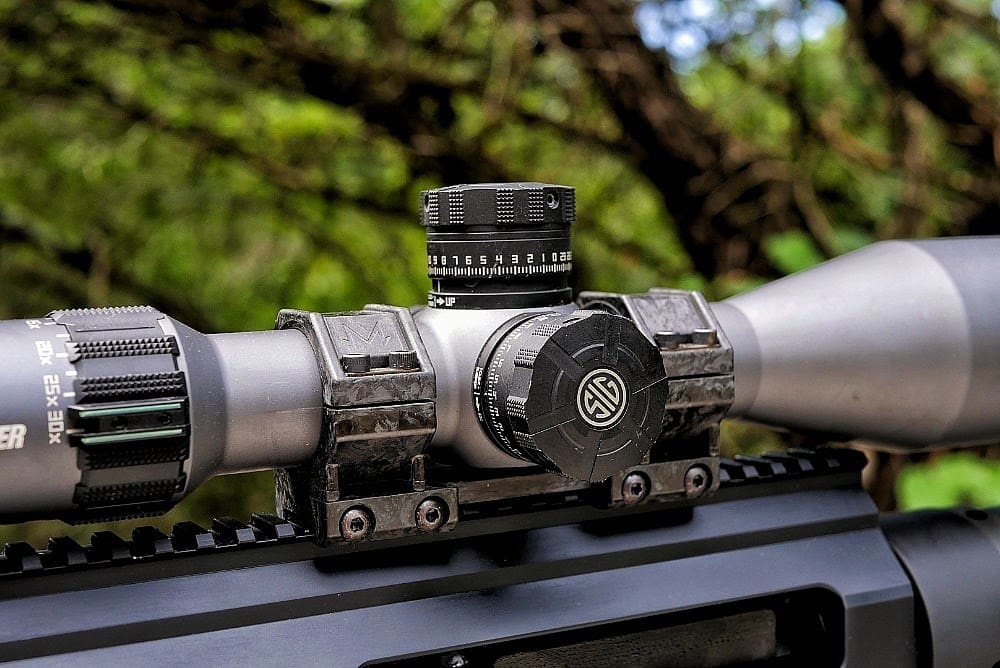
Despite the limited and exclusive nature of the Forged Carbon Fiber One-Piece Scope Mounts and their physical advantages over aluminum mounts, not to mention their drop-dead gorgeous looks, MSRP is in-line with other premium scope mounts.
More information can be found at: https://blackcollararms.com/
About Black Collar Arms
Based in Austin, TX, Black Collar is dedicated to creating innovative and functional firearms and components. The Pork Sword Chassis forged the market for minimalist, modular firearm chassis and the Pork Sword Pistol is now headed to a dealer near you. There’s a lot more to come from Black Collar, so stay tuned!
Questions, feedback, concerns, or naughty pics to share? Email our boy Jeeves at [email protected] or find us on Instagram, Facebook, and www.BlackCollarArms.com

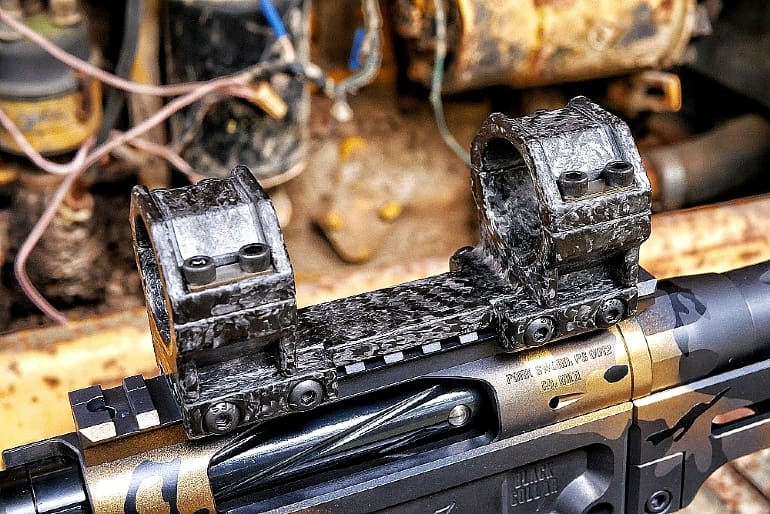
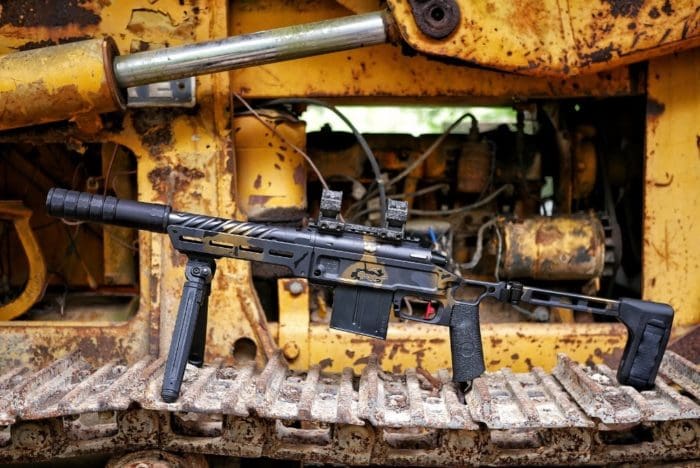



I’m an F1 fan, they use lots of carbon fiber. When cars bump, all manner of carbon fiber pieces shatter into razor-sharp pieces scattered around the area. If I smack these mounts with a hammer with enough force that it might knock a steel mount off target a little, will they disintegrate, leaving the scope lying on the ground?
An f1 car is designed to breakup when hitting an object to help lessen the force of impact. The chassis of an f1 car and the “tub” around the driver is also made of carbon fiber, but it’s designed to stay together to protect the driver. If you watch a crash, the wheels and wings will break away from the main portion of the car and the “tub” around the driver will remain intact.
I’m sure this carbon scope mount is designed to take a beating and stay together.
I doubt both rings will fail at the exact same time. The unbroken ring will keep it from falling.
You do bring up a legitimate point, claims of super-rigidity means *brittle*, and I’d be leery about exposing it to shock like being dropped, which happens on hunting trips when negotiating rocks and other obstacles…
Years ago, the Department I worked for tested carbon-fiber collapsible batons. They were fast to deploy and light to swing and had the annoying habit of feathering and disintegrating when struck on a hard edge (we did not adopt the carbon models, instead, staying with the collapsible steel baton).
Kind of cheesy not to mention the MSRP in the actual TTAG article (clicking the link informs the reader that the price is $399.99).
Thank you, I think I’ll stick with my Warne QD rings and Pic rails…darn near indestructible.
Well like they say, if you gotta ask how much, you probably couldn’t afford it anyway…
Or maybe you have the money, but want to know if it is waste of time or worth your time. Knowing all the facts, inculding cost is the best way to make an informed decision.
I know four millionares & a few retired gentlmen who have a seven digit income & none of them use that silly saying.
To be completely candid here, it’s preferable to leave MSRP out of a press release if you can. Makes it less painful if we change the MSRP later, and is likely to drive more traffic to our website than if ALL the info is in the press release. Since these things live on the interwebs literally forever, even if the MSRP goes up three years from now due to inflation we’ll get five emails a day claiming misleading advertising for a lower MSRP in an old press release or asking for us to honor the old price or etc etc etc 😉 🤷♂️. The website is a living document, but this press release isn’t. So…that’s why it’s alluded to but not specified.
Appreciate your candidness…thank you.
In order to hook my interest in a product, a press release or review should include mentioning the price (the question being: does the product appeal enough to me to justify figuring it into my budget?)
the article has a date on it. duh.
Gus, you have to understand how stupid the average person is, and that half of the population is more stupid than that person.
Your scope tube will bend before these rings are affected. They’re incredibly strong and resilient. We’ll be doing some abusive test stuff on video soon.
…FWIW Callaway makes club heads with this process (including hollow, thin-walled drivers), Lamborghini makes suspension arms, structural frames/tubs, and nearly every other part of a vehicle’s body, frame, seats, suspension components, etc with this stuff. A snowboard binding company made thin, lightweight bindings that were far more resilient than their metal and their FRP ones with this process and won some awards with the design. It really will hold your scope 😉
Thanks for the response, that makes me more confident, knowing “Carbon fiber” is not always the same thing with the same qualities, but is produced with the qualities desired for the application. Wish you luck with your enterprise!
Are the holes just drilled through the fiber or are they bushed or reinforced by some method? I spent 10 years in the aerospace industry working with carbon Fiber, carbon bismaleimide, Kevlar, quartz bis, and other exotics and the point of failure was never with the structure itself, but with the mounting holes.
Look closely at the second photo.
@JWT – That’ll work.
Holes are molded in rather than drilled, hardware contact areas are reinforced. Stainless steel thread inserts are molded in depending on application.
Years ago worked on a DoD project with both Glass Fiber (GF) and Carbon Fiber (CF) reinforced Nylon (PA 6/6). Found that if the mold steel temperature was ~250’F, 33% CF PA 6/6 would be close to the strength properties of 1018 Cold Rolled steel. In real time testing, found that for a rocket propelled grenade system being developed, the 1018 CR Steel Fins would snap off, but the 33% CF PA 6/6 Fins would flex and stay together.
IF properly made, CF reinforced polymers can easily work as a substitute for 1018 CR Steel, but have both a weight savings and better “give”.
“…gorgeous carbon fiber aesthetic”
Are we seeing the same thing? Because to my eye that finish is nasty. Would prefer a nice layer of twill prepreg on the outside, instead of looking like someone took a die grinder with a Norton blaze to it.
The chopped, multi-directional carbon fiber look is part of the forged carbon fiber process for multiple reasons. One, it’s strong in all dimensions instead of its strength aligning primarily along the axes of the carbon fiber weave. Two, it’s capable of taking complicated shapes including inside and outside corners and edges, even in fine detail, which cannot be done with woven CF — those strands are limited in how much they can bend, which is why you end up with corners and edges made mostly of empty epoxy and susceptible to cracking. This process, forged under high pressure and with varying lengths of and every-direction of carbon strands is what allows such incredible strength, resilience, and the ability to assume sharp, fine details.
I used to LOVE the look of woven CF, but the more modern, more randomized look of the forging process has surpassed it for me. The more CF barrels and Lamborghini components and rocket parts and other extremely high-physical-demand parts I see using this method, and coming to realize that the weave style has now been mostly relegated to the realm of aesthetic use parts while this style is what’s used for creating physically strong components shifted my preference. Plus the way it catches the light and gives you that CF depth but without the predictable twill pattern is kind of awesome.
Appreciate the reply, and dropping the knowledge for the public.
I know, & I understand the reasoning (I’ve worked in the composite industry myself, CF as well as other more exotic). More to the point, my comment was directed at the aesthetic value the author stated, not at the product itself.
To be fair, I’m a function over form guy, but sometimes that leaks over a bit to the other side of the equation. I like pretty sometimes too.
I authored the press release 🙂. Yes, I suppose aesthetics are entirely subjective haha. No arugment from me if you like the other look better!
Ah, well staff writer is non-specific here, and I didn’t follow up at your site. Not realizing my reply was directly to you. 😉
Agree, subjective is subjective. As said earlier, I follow meritocracy principles, if or when I have a chance to do a hands on, I’ll give it a fair shake. Probably literally. :p
Dude, you’re rocking the answers!! I wish more companies would have direct answers.
Carbon is the real deal. I ride my carbon bike at 20+ mph downhill, through rock gardens and over jumps without ever the worry of it breaking.
These rings will rock. But they would only be on a dream build hunting rifle as the price excludes them from all my rifles.
I love the look and great that your company is doing this. In the end we all benefit as this will push others to think outside the bun. Hell, without mountain bikes the world would still be riding crappy road bikes with crappy everything on them.
I personally couldn’t give two squirts to how it looks, so long as it’s not blinding, flashing neon lights.
If it’s strong and light and not too terribly bulky, I can see it being a huge addition to an overall ultra-light build. Ounces wind up equaling pounds, and one more part you can shave ounces off (that in the past you haven’t really been able to by much), is pretty big.
One thing that I am unclear on, is the mention of “thermal expansion”. As far as I know, Carbon Fiber shrinks when it heats up, opposite metal, which expands.
I could be wrong, of course. Not that scope mounts ever really take much of a thermal load to begin with, so I see it as a moot concern.
“As far as I know, Carbon Fiber shrinks when it heats up, opposite metal, which expands.”
Is that an issue of the CF itself, or the resin binder?
“Thermal expansion” actually means the increase OR decrease in size due to changes in temperature. What matters here is that forged carbon fiber changes 1/6th the amount of aluminum, which reduces temperature-induced point of impact shift or loosening of the rings’ clamp pressure on your scope, loosening of hardware, etc. Plenty of folks out there hunting, with the same gun, in triple digit summer temps and single digit winter temps where this can actually matter.
These are cool…but I’m “frugal”. I’ll stick to the cheap stuff from Wal-Mart 😏😏😏
“These are cool…but I’m “frugal”.”
Same here. I see a 400-dollar price tag and think “I can get a cheap 300 BLK upper for that money”, and have an extra caliber to play with…
I can totally understand that. Keep an eye out for red dot mounts though, molds will be less complicated and of course less material per mount.
The limit with these exotic materials is their thermal coefficients of expansion. Their TCEs don’t match the more conventional materials they are fixed to – like aluminum scope bodies – so very high stress levels can develop and create premature failures. The only question is whether the fractures occur in the conventional material or the exotic material.
Mechanical engineers can limit these TCE failures by incorporating strain reliefs into their designs, but often neglect such details.
“The limit with these exotic materials is their thermal coefficients of expansion.”
How much of that is a realistic issue for something like scope rings?
Depends on how much temperature change there is, and upon engineered stress relief.
For 6061 and 7075 aluminum the TCE is around 13e-6 per deg F … so if your scope body is 1″ in diameter at 70 deg, at 150 deg (and you left it on the dashboard why?) it’s expanded to 1.001″. That extra thou might not seem like much, but something will need to move to accommodate it.
“The only question is whether the fractures occur in the conventional material or the exotic material.”
Or, indeed, not at all.
Keep your mounted scope out of the oven and you’ll be fine. Torque specs and ring cap design accommodate for this theoretical concern as well as for tolerance variation between different manufacturers (and scope-to-scope from certain manufacturers).
Some high school girl in Japan has found some stuff you put in plastic to keep fish from eating it.
Fantastic. Has anyone told the turtles? These paper straws are making me suicidal.
Turtles can’t speak Japanese can they, I don’t think? They do kinda got slanty eyes.
That’s the type of response i’ d like to see from every manufacturer when legitimate questions are asked. Well done Black Collar Arms.
I have been looking at getting a 34mm one piece Sphur mount with a 6 mil cant for my precision rifle. I would really like to see a comparision. This mount looks real interesting, and aimed at that segment of the market, where rugged rock solid mounts are needed.
Yes, it’s right in that same segment for sure. It’s rock freaking solid — more so than the competition — but weighs about 40% less. You do lose out on the ability to mount accessories, though, as Spuhr and some others are covered in threaded holes so you can bolt reflex sights and range finders and cup holders and whatever else onto them. Our forged carbon fiber offerings won’t have that option.
“and cup holders and whatever else onto them.”
But, but, but – if I can’t mount my 1/2 gallon Alladin thermos to my mounting rings, how will I carry it to the tree stand?
Sorry, that one cracked me up.
What cracked me up was my vision of you pouring coffee out of it.
I appreciate the forward advancement that Black Collar Arms is doing. I wouldn’t be surprised if a carbon fiber ar-15 upper and lower came out soon (with an insert for the bolt). I’m not an engineer, but from the limited knowledge I have, I’m pretty sure that carbon fiber isn’t capable of handling the friction of a moving bolt. Black Collar Arms, do you have a store front? I recently moved to Austin….on second thought, I’m not sure I want to handle your pork sword.
But that’s the beauty of capitalism. Storefront or not, you don’t ever have to handle somebody else’s. Buy one, and then you can handle YOUR pork sword all you want. 🙂
We do not yet have a customer-friendly location. We’re hoping to change that this fall/winter (currently looking at a place under construction that’s supposed to be ready Nov 1, but there’s no shortage of commercial space right now if we pass on this one).
Bushmaster did the Carbon 15 (originally designed by a company called Professional Ordnance), which used a carbon fiber lower and upper. It wasn’t really carbon fiber how we think of it now, either in woven molded form or in forged form, but effectively identical to FRP where it was injection molded like any normal fiber reinforced polymer (e.g. like a Magpul magazine) but they used teeny tiny little carbon fibers and dust instead of fiberglass fibers. The lowers were fine; very few issues. The uppers wore out, though. They really should have sleeved the upper with a thin aluminum or steel insert to prevent the bolt (which was a proprietary design but wouldn’t have had to be with a sleeve) from wearing away the polymer, and also used a metal insert for the feed lips. Anyway, I think they eventually gave up and started making the Carbon 15 uppers from aluminum 😆.
This forged CF process would hold up far better, but still isn’t appropriate in a wear surface application. We could absolutely do lowers (or Pork Sword Chassis) with this process, but the size and complexity would make them awfully expensive.
barrels?
Given time and money probably, may be a bit sooner than I would have thought if these have anything near the durability of steel.
This is just a tease. Now that we know someone is bringing forged carbon parts to the firearms industry, we want forged carbon AR uppers and lowers for a traditional looking build that is super light weight and durable.
That was my first thought.
Polymer AR lowers that don’t fall apart or stretch out of shape.
If people will pay $200-300 for a billet lower, can you make a carbon lower for under $500?
Maybe, I’d sure like to one day. Got a whole list of stuff though so who knows.
GWACS polymer lowers are what you are looking for. Or today, KE Arms KP-15. (coming soon).
https://www.brownells.com/guntech/wwsd2020/detail.htm?lid=17958
I’ve got a GWACS clone (they made them for a couple of other companies for a hot minute), a Sabre Defense lower. Held up to a few hundred rounds of 6.5 grendel so far. No indication of wear or other issues. InRangeTV has tested the heck out of the Gen 3 GWACS lowers and they are in general more robust than an aluminum lower.
Mine DID take some tweaking to get right. Need to mill out the magwell slightly to take 6.5 grendel mags and polymer mags (was designed when almost no one had heard of PMAGS). Bolt release needed the flashing cleaned up slightly. My LaRue trigger also was a hair too tight so I needed to lightly sand and then polish the trigger pocket (it worked fine with my generic mil spec trigger).
It weighs about 4oz lighter than a regular aluminum lower, with m4 butt stock, aluminum castle nut and end plate (not steel ones). Shaved another .7oz by getting aluminum take down and pivot pins from GWACS a couple of years ago.
Is that like a pre-preg process
“one third the weight of titanium…”
Ohhhhh. Sweet. *Checks actual weight*. Hmm, that’s as much as the set of aluminum rings I have. *checks Aero Precision rings*, hmmm my other rings are 2/3rds the weight…and 1/5th the cost.
Perhaps these are even more rugged, but Aero’s mount doesn’t give me any concerns on its durability. I mean, unless maybe I decide to drive nails with it. At which point the rail or the scope are likely to fail first.
Can’t fairly compare a wide ringed (6 bolt) mount to a set of skinny little rings. I’d say I’m doing pretty good if you compare it to similar products, or even that my weight is that of a pair of little rings. There’s stuff I have coming out that focuses on light weight. This mount focuses on maximum rigidity and rock solid clamping and max strength with almost no weight saving features in the design really at all — that’s just a side effect of the material. Black Collar and I will target the lightweight market soon enough.
Why are you comparing a wide ring 6 bolt mount? Yours is a 4 bolt mount. I’d love a light mount, but a $200 premium to shave 3.3 oz of of an equivalent american defense mount and you give up QD as a feature to boot.
While your mount is likely easier to set up than the hinged aero mount, the aero mount is 3.2 oz, works well once set up, is durable, won’t sugar from UV exposure and saves you almost $300. That’s a lot to argue against.
Heck, I run a 34mm AD recon-x, and I’d pay a premium to get the convenience and form factor at half the weight. But the juice would have to make the squeeze worth it.
Because mine is a wide ring mount (1.06”)…….just uses four bolts. I only added that because that what most wide rings are. Measurements are available on my website for reference.
It saves weight but that was not the design focus of this mount at all. I personally think the best feature is the ring caps they are in a loaded position when torqued down. Less chance of vibrating loose. None of products have an issue with UV light.
I mean, the mount I have that is 5.7oz is aluminum and a wide ring mount. I use it on my 24″ 6.5 grendel upper. I forget the manufacturer (not a well known one). No I have not abused the heck out of it. But it has had no issues in a few years of use and the occasional whack on the range and in the safe (because sometimes I don’t rest it right, its tipped over and landed on its side a few times, once on the scope/scope mount without breaking anything). I’ll grant its only a 1″ mount, so a 34mm would be somewhat heavier.
I do get it is not exactly equivalent. But it is a juice-squeeze question. To get bomb proof, likely way more robust than any scope is and probably an ounce or two of weight savings (yes I know some scope mounts are like 10-14oz, plenty are not), its $300+ more (okay, like $100-200 more than other high end 34mm tube mounts). I know I am complaining I am not the target market. I am just partly trying to figure out what the target market is. Actual snipers/DMR that are carrying big, heavy glass on a big, heavy rifle and need something they can leverage a Humvee out of a ditch with, but also want to save the weight of a couple rounds of .308 off their 14lb rifle?
A bench gun, the weight isn’t much of a factor (and if anything, heavier is probably better) isn’t it. I can’t think of any hunters I am aware of that use a 34mm tube on their rifle.
You’re correct; the benefit here is bombproof zero retention with extreme rigidity and secure scope hold, etc etc., and weight savings is a bonus but not part of the design focus. I would just say, if you could save them some weight on their big heavy rifles that’s awesome and yeah the bench shooter isn’t going to care, their gun is heavy as is, but what if you didn’t have to worry as much about bolts backing off. part of running this material that is prob my favorite, is the ring caps are loaded like what I said in another comment it’s a mixture of things rigid, rings aren’t going to settle(stretch) over time, maybe a little but nothing compared to aluminum, and weight although I understand it’s not the huge difference people are expecting. Also this is just me defending something I’ve been working a lot on but I think titanium hardware is definitely in the books and if I remember right the alloy steel hardware alone is 1.08ounces. Lots of hunters/shooters around where I’m from run one piece mounts on a lot of their rigs so from plinking to hunting to competition.
I also do 30mm stuff as well and have more coming out in the future in partnership with Black Collar, so hopefully something in the future matches your needs and you give us a shot.
Awesome application! I’ll be following.
THANK YOU!